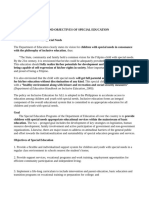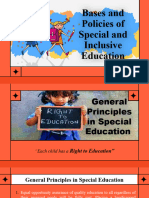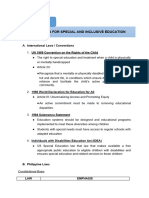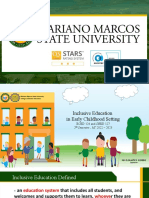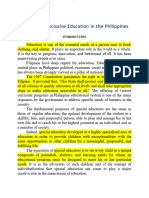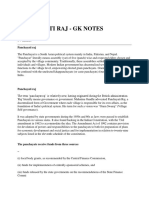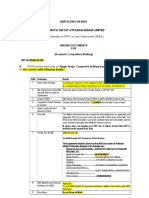0 ratings0% found this document useful (0 votes)
46 viewsED 104 Midterm
ED 104 Midterm
Uploaded by
Razyl EdioThe document discusses the legal bases and history of special education in the Philippines. It notes several key laws that were enacted to promote the education of students with disabilities, including the 1935 law asserting the rights of every child, the 1963 law providing training for special education teachers, and the 1968 law establishing a teacher training program. The 1982 Education Act and 1987 Constitution also affirmed the right to education for all students. Subsequent laws addressed accessibility, child protection, rehabilitation, and newborn screening. The Individuals with Disabilities Education Act of 1975 had a similar goal of ensuring education services for students with disabilities in the United States.
Copyright:
© All Rights Reserved
Available Formats
Download as DOCX, PDF, TXT or read online from Scribd
ED 104 Midterm
ED 104 Midterm
Uploaded by
Razyl Edio0 ratings0% found this document useful (0 votes)
46 views3 pagesThe document discusses the legal bases and history of special education in the Philippines. It notes several key laws that were enacted to promote the education of students with disabilities, including the 1935 law asserting the rights of every child, the 1963 law providing training for special education teachers, and the 1968 law establishing a teacher training program. The 1982 Education Act and 1987 Constitution also affirmed the right to education for all students. Subsequent laws addressed accessibility, child protection, rehabilitation, and newborn screening. The Individuals with Disabilities Education Act of 1975 had a similar goal of ensuring education services for students with disabilities in the United States.
Original Description:
Review
Copyright
© © All Rights Reserved
Available Formats
DOCX, PDF, TXT or read online from Scribd
Share this document
Did you find this document useful?
Is this content inappropriate?
The document discusses the legal bases and history of special education in the Philippines. It notes several key laws that were enacted to promote the education of students with disabilities, including the 1935 law asserting the rights of every child, the 1963 law providing training for special education teachers, and the 1968 law establishing a teacher training program. The 1982 Education Act and 1987 Constitution also affirmed the right to education for all students. Subsequent laws addressed accessibility, child protection, rehabilitation, and newborn screening. The Individuals with Disabilities Education Act of 1975 had a similar goal of ensuring education services for students with disabilities in the United States.
Copyright:
© All Rights Reserved
Available Formats
Download as DOCX, PDF, TXT or read online from Scribd
Download as docx, pdf, or txt
0 ratings0% found this document useful (0 votes)
46 views3 pagesED 104 Midterm
ED 104 Midterm
Uploaded by
Razyl EdioThe document discusses the legal bases and history of special education in the Philippines. It notes several key laws that were enacted to promote the education of students with disabilities, including the 1935 law asserting the rights of every child, the 1963 law providing training for special education teachers, and the 1968 law establishing a teacher training program. The 1982 Education Act and 1987 Constitution also affirmed the right to education for all students. Subsequent laws addressed accessibility, child protection, rehabilitation, and newborn screening. The Individuals with Disabilities Education Act of 1975 had a similar goal of ensuring education services for students with disabilities in the United States.
Copyright:
© All Rights Reserved
Available Formats
Download as DOCX, PDF, TXT or read online from Scribd
Download as docx, pdf, or txt
You are on page 1of 3
ED 104 4.
Legal Bases of Special Education
1. Vision- -The first legal basic of the care and protection of children with disabilities was
enacted in 1935. Articles 356 and 259 of Commonwealth Act NO, 3203, asserted
“The State, community and family hold a common vision for the Filipino child with special "the right of every child to live in an atmosphere conducive to his physical, moral and
needs. By the 215t century, it is envisioned that he/she could be adequately provided with intellectual development" and the concomitant duty of the government "to promote the
basic education. This education should fully realize his/her own potentials for development full growth of the faculties of every child."
and productivity as well as being capable of self-expression of his/her rights in society.
More importantly, he/she is God-loving and proud of being a Filipino. -Republic Act No. 3562, "An Act to Promote the Education of the nes" on
June 21, 1963 provided for the formal training of special education teachers of
2. Policy blind children at the Philippine Normal College, the rehabilitation of the Philippine
The policy on Inclusive Education for All is adopted in the Philippines to accelerate access National School for the Blind (PNSB) and the establishment of the Philippine
to education among children and youth with special needs. Inclusive education forms an Printing House for the Blind.
integral component of the overall educational system that is committed to an appropriate -Republic Act No. 5250, “An Act Establishing a Ten-year Teacher Training
education for all children and youth with special needs. Program for Teachers of Special and Exceptional Children” was signed into
law in 1968. The law provided for the formal training of teachers for deaf, hard-of-
3. Goal hearing, with speech impairment, socially and emotionally disturbed, intellectually
disabled and mentally gifted children and youth at the Philippine Normal College
The goal of the special education programs of the Department of Education all over the and the University of the Philippines,
country is to provide children with special needs appropriate educational services within -The Education Act of 1982 or Batas Pambansa Bilang 232 states that “the
the mainstream of basic education. The two-pronged goal includes the development of state shall promote the right of every individual to relevant quality education
key strategies on legislation, human resource development, family involvement and active regardless of sex, age, breed, socioeconomic status, physical and mental
participation of government and non- government organizations. Likewise, there are major condition, social and ethnic origin, political and other affiliations.
issues to address on attitudinal barriers of the general public and effort towards the -Section 24 “Special Education Service” of the same law affirms that “the State
institutionalization and sustainability of special education programs and services. further recognizes its responsibility to provide, within the context of the formal
education system services to meet special needs to certain clientele.
A. Special education aims to:
-1983, Batas Pambansa Bilang 344 was enacted. The Accessibility Law, “An
a. Provide a flexible and individualized support system for children and
Act to Enhance the Mobility of Disabled Persons” requires cars, buildings,
youth with special needs in a regular class environment in schools
institutions, establishments and public utilities to install facilities and other devices
nearest the students’ home.
for persons with disabilities.
b. Provide support services, vocational programs and work training,
-The 1987 Constitution of the Philippines cites the rights of exceptional children
employment opportunities for efficient community participation and
to education in Article XIV.
independent living.
-Section I declares that the “State shall protect and promote the right of
c. Implement a life-long curriculum to include early intervention and parent
all citizens to quality education at all levels and shall take appropriate steps to
education, basic education and transition programs on vocational training
make such education accessible to all.
or preparation for college and
Section 2 emphasizes that “the State shall provide adult citizens, the
d. make available an array of educational programs and services: The
disabled and out-of-school youth with training in civics, vocational efficiency and
Special Education Center built on "a school within a school concept" as
other skills.”
the resource center for children and youth with special needs; inclusive
-1989, R.A. No. 6759 was enacted. The law declared August 1 of each year as
education in regular schools, special and residential schools; homebound
“White Cane Safety Day in the Philippines.”
instruction, hospital instruction and community-based programs;
-1992, R.A. No. 7610 was enacted. The law is “An Act Providing for Strong
alternative modes of service delivery to reach the disadvantaged children
Deterrence and Special Protection Against Child Abuse, Exploitation and
in far-flung towns, depressed areas and underserved barangays.
Discrimination, Providing Penalties for Its Violation and Other Purposes.”
-1992, RA 7277 was enacted. The law is “An Act Providing for the Rehabilitation, b. Recalling. The several United Nations declarations culminating in the 1993
Self-development, Self-reliance of Disabled Person and their Integration into the United Nations Standard Rules on the Equalization of Opportunities for
Mainstream of Society and for Other Purposes” otherwise known as the Magna Persons with Disabilities
Carta for Disabled Person. c. Noting. With satisfaction the increased involvement of governments,
-The year 2004 ushered in a landmark legislation spearheaded by the advocacy groups, community and parent groups, as evidence of this
Department of Health, Republic Act No. 9288 otherwise known as “The New- involvement the active participation of high-level representatives of numerous
born Screening Act of 2004• Individual with Disabilities Education Act (IDEA) governments, specialized agencies and intergovernmental organizations in
of the United States this World Conference.
-In 1975, Public law 94 -142, the Individual with Disabilities Education Act
(IDEA) was enacted in the United States. The IDEA is a wide-ranged legislation 7. Special Education
ensuring the services including the education of children with disabilities
throughout the nation. IDEA governs how the states provide the PWD’s who are -The practice of educating student in a way that accommodates their individual
between the ages of 3 to 21, early intervention, special education and related differences, disabilities and special needs. Involves the individually planned and
services. systematically monitored arrangements of teaching procedures. (Demerits: Destroys
confidence/isolation)
5. The Six Major Principles in organizing and implementing special education 8. Inclusive Education
programs (Heward, 2003):
a. Zero reject. Schools must enroll every child, regardless of the nature or -Providing education to especially abled students along with normal students and by
severity of his or her disabilities; no child with disabilities may be excluded providing facilities and normal atmosphere as given to normal students.
from a public education.
b. Non-discriminatory testing. Schools must use non-biased, multi-factored 9. Integrated Education
methods of evaluation to determine whether a child has a disability and, if so,
-It is a system of providing formal education for differently able students in the
whether special education is needed.
mainstream institutions, but in separate classrooms exclusively formed only for
c. Appropriate education. Schools must develop and implement on
differently abled students.
individualized education program (IEP) for each student with a disability.
Least Restrictive Environment. School must educate students with 10. Disability, impairment and Handicap
disabilities,
d. Due process. Schools must provide safeguards to protect the right of a. Impairment- any loss or abnormality of physiological, psychological or anatomical
children with disabilities and their parents by ensuring due process, c structure or function. (Being Born Blind)
e. Parent participation. Schools must collaborate with the parents of students
b. Disability- any restriction or lack of ability to perform an activity in the manner
with disabilities in the design and implementation of special education
considered as normal being. (Blind person who cannot read)
services.
c. Handicap- the result when an individual with an impairment cannot fulfill a normal
6. UNESCO Salamanca Statement life role. (blind who cannot got to school)
-The Salamanca Statement and Framework for Action on Special Needs Education, 11. Individuals that contribute to SEd
the World Conference on Special Needs Education: Access and Quality, Salamanca,
Spain, 7-10 June 1994. a. Fred Atkinson- found in census about deaf and blind.
Main provisions relating to right to education: b. David Barrow- Director of Public Education
a. Reaffirming. The right to education of every individual, as enshrined in the c. Delia Rice- American Educator, first administrator and teacher of the special school
1948 Universal Declaration of Human Rights, and renewing the pledge
made by the world community at the 1990 World Conference on Education d. Maria Villa Francisco- first Filipino principal (SDB)
for All to ensure that right for all regardless of individual differences.
You might also like
- The Mental Game TradingDocument40 pagesThe Mental Game TradingSebasUshii100% (1)
- Herban Industries v. Eaze Technologies - ComplaintDocument72 pagesHerban Industries v. Eaze Technologies - ComplaintBen Adlin67% (3)
- Re L (A Child) (Contact Domestic Violence) and Other Appeals (2000)Document36 pagesRe L (A Child) (Contact Domestic Violence) and Other Appeals (2000)Joshua Lawson CowieNo ratings yet
- Storz Xenon 300 Light Source - Service ManualDocument75 pagesStorz Xenon 300 Light Source - Service ManualISRAEL MACEDO100% (1)
- Historical and Legal Foundation of Special Education 1Document7 pagesHistorical and Legal Foundation of Special Education 1Ma Sherhan Dolit100% (1)
- Local Labor Complaint FormDocument1 pageLocal Labor Complaint FormYVONNE PACETE50% (2)
- EDUC112 M2 L1 Policies and Guidelines and Historical PerspectiveDocument25 pagesEDUC112 M2 L1 Policies and Guidelines and Historical PerspectiveTessa LioberasNo ratings yet
- Special Education ReviewerDocument14 pagesSpecial Education ReviewerGuiang, Maezynelle P.No ratings yet
- SPECIAL EDUCATION BEEd IIDocument41 pagesSPECIAL EDUCATION BEEd IIDanica Hipulan HinolNo ratings yet
- Sped Chapter 1 Lesson 1 Goals Objectives and Policy of SPEDDocument27 pagesSped Chapter 1 Lesson 1 Goals Objectives and Policy of SPEDCrizza Mae PagalaNo ratings yet
- Inclusive EducationDocument17 pagesInclusive Educationlevy_acuna08No ratings yet
- In The Philippines: Special EducationDocument24 pagesIn The Philippines: Special EducationLiezel Evangelista BaquiranNo ratings yet
- Foundations of Special and Inclusive Education Handouts 1Document3 pagesFoundations of Special and Inclusive Education Handouts 1Jezzel May ElloricoNo ratings yet
- 4. Legal BasesDocument24 pages4. Legal BasesestrevencionaleahNo ratings yet
- English LietratureDocument13 pagesEnglish LietratureForeducationalpurposeonlyNo ratings yet
- Fosie Review MaterialDocument18 pagesFosie Review MaterialcontaoecherryNo ratings yet
- Policies and Legal Bases of Inclusive and Special EducationDocument25 pagesPolicies and Legal Bases of Inclusive and Special EducationJOICE NIELES100% (1)
- Educational Legislation in The Philippines 184Document9 pagesEducational Legislation in The Philippines 184leahmae.mandinNo ratings yet
- Republic Act No. 5250 Presidential Decree No. 1509Document2 pagesRepublic Act No. 5250 Presidential Decree No. 1509Carol GorresNo ratings yet
- ECEINCDocument76 pagesECEINCthebonafidebossNo ratings yet
- Ed4 Module3Document4 pagesEd4 Module3maotsdsriNo ratings yet
- Advocacy For Inclusive Education 5Document47 pagesAdvocacy For Inclusive Education 5Angelica BatiquinNo ratings yet
- Fsie L3Document2 pagesFsie L3KennethNo ratings yet
- Legal Bases of Special and Inclusive EducationDocument31 pagesLegal Bases of Special and Inclusive EducationTheresa Jane Ho-Farma100% (1)
- Guiding Principles Policies and Legal Bases of Special EducationDocument16 pagesGuiding Principles Policies and Legal Bases of Special EducationJu DumplingsNo ratings yet
- Inclusive Eduation DefinedDocument21 pagesInclusive Eduation DefinedMark DaveNo ratings yet
- Cpe 103 Prelim - Lesson 1Document41 pagesCpe 103 Prelim - Lesson 1Herlene Padayao PahamtangNo ratings yet
- Tulio - Beed 1B - Educ 4 - Legal Bases of Special and Inclusive EducationDocument3 pagesTulio - Beed 1B - Educ 4 - Legal Bases of Special and Inclusive EducationCharisse DeirdreNo ratings yet
- Fsi NotesDocument25 pagesFsi Notesjeanella choiNo ratings yet
- group 1 & 2 foundationDocument2 pagesgroup 1 & 2 foundationleinate.iskolarNo ratings yet
- Legal Bases for Special and Inclusive EducationDocument4 pagesLegal Bases for Special and Inclusive EducationMiguela LabiosNo ratings yet
- Legal Bases of SpEd in PHDocument40 pagesLegal Bases of SpEd in PHKhristyl Guillena100% (1)
- SpEd 03 Sped Historical & Legal Bases PhilDocument4 pagesSpEd 03 Sped Historical & Legal Bases PhilVillaren VibasNo ratings yet
- Inclusion-in-Early-Childhood-EducationDocument35 pagesInclusion-in-Early-Childhood-Educationleinate.iskolarNo ratings yet
- Inclusive EducationDocument4 pagesInclusive Educationhft66v8tjcNo ratings yet
- Summary of ReportDocument5 pagesSummary of ReportKc Alecks V. BaliwasNo ratings yet
- Introduction To Foundation of Special and Inclusive EducationDocument19 pagesIntroduction To Foundation of Special and Inclusive EducationLovelyNo ratings yet
- Medija - Summary of Philippine Legal Basis For Inclusive EducationDocument4 pagesMedija - Summary of Philippine Legal Basis For Inclusive EducationNicole MarceloNo ratings yet
- SPED Legal Bases PDFDocument99 pagesSPED Legal Bases PDFCHRISTINE JOY TOMINAGANo ratings yet
- HandoutDocument27 pagesHandoutReeree GampalNo ratings yet
- Special EducationDocument23 pagesSpecial EducationGuila MendozaNo ratings yet
- SPED ReviewerDocument3 pagesSPED Reviewerpersonal.ton0913No ratings yet
- For Recitation FoedDocument3 pagesFor Recitation FoedPrincess Says MarquezNo ratings yet
- Constitutional Provisions Child Welfare PDFDocument41 pagesConstitutional Provisions Child Welfare PDFKt KateNo ratings yet
- Inclusive and Special Education Powerpoint ReportDocument21 pagesInclusive and Special Education Powerpoint ReportKe Ann Libradilla100% (5)
- Historical TimelineDocument21 pagesHistorical TimelineMariell Mae GamitNo ratings yet
- Educ 148 Chapter II A4Document10 pagesEduc 148 Chapter II A4Michelle YadaoNo ratings yet
- Legal Basis On Special EducationDocument15 pagesLegal Basis On Special EducationHearthy AnneNo ratings yet
- Matrix XXDocument11 pagesMatrix XXJhon YaunNo ratings yet
- History of Special EducationDocument4 pagesHistory of Special EducationJoseph GratilNo ratings yet
- Inclusive Education K To 12 CurriculumDocument2 pagesInclusive Education K To 12 CurriculumLESLIE MAY NUNEZNo ratings yet
- Resh DocumentDocument8 pagesResh DocumentReshelleNo ratings yet
- Martinez, Linel R. Bcaed 1B TaskDocument4 pagesMartinez, Linel R. Bcaed 1B TaskLinel MartinezNo ratings yet
- CATE100 Lecture Notes Week 2 Part 1Document99 pagesCATE100 Lecture Notes Week 2 Part 1Reyza RoldanNo ratings yet
- Legal FoundationsDocument30 pagesLegal FoundationsmedianakathrineNo ratings yet
- Sped-1 1Document16 pagesSped-1 1jessa mae maguinNo ratings yet
- History ofDocument4 pagesHistory ofjhony.valenzuela12No ratings yet
- Prof Ed 8 - Module 2 - Aguilar Jesanne GDocument5 pagesProf Ed 8 - Module 2 - Aguilar Jesanne GJesanne AguilarNo ratings yet
- Mam BallerasDocument3 pagesMam BallerasBrev SobremisanaNo ratings yet
- 1 BLegalBasesDocument14 pages1 BLegalBasesRealyn Francisco100% (1)
- FSIE NotesDocument1 pageFSIE NotesCielito SantosNo ratings yet
- MODULE 1 Lesson 1Document24 pagesMODULE 1 Lesson 1Glenn RadisNo ratings yet
- Education for All: Strategies for Students with Special Needs: Innovative Education: Strategies, Challenges, and Solutions in PedagogyFrom EverandEducation for All: Strategies for Students with Special Needs: Innovative Education: Strategies, Challenges, and Solutions in PedagogyNo ratings yet
- Educating Learners With Visual Impairment In ZambiaFrom EverandEducating Learners With Visual Impairment In ZambiaRating: 5 out of 5 stars5/5 (1)
- Stormwater Ceu Training Course $100.00: Registration FormDocument18 pagesStormwater Ceu Training Course $100.00: Registration FormAhmed ZakiNo ratings yet
- Instant Download Engaging Bioethics An Introduction With Case Studies 1st Edition Seay PDF All ChaptersDocument62 pagesInstant Download Engaging Bioethics An Introduction With Case Studies 1st Edition Seay PDF All Chaptersminamaboggio100% (4)
- Induslaw Competition Law Year in Review 2020Document10 pagesInduslaw Competition Law Year in Review 2020AnjaliSinghNo ratings yet
- Panchayti Raj SystemDocument3 pagesPanchayti Raj Systemkunal mehtoNo ratings yet
- GAD Jose D. Udasco Mangangan I National High SchoolDocument9 pagesGAD Jose D. Udasco Mangangan I National High SchoolCharlyn VillaruelNo ratings yet
- Registration of Press and Periodicals (RPP) Bill, 2019Document3 pagesRegistration of Press and Periodicals (RPP) Bill, 2019shivesh sainiNo ratings yet
- EO Posting Order 14.03.2024Document2 pagesEO Posting Order 14.03.2024krishan.theiaNo ratings yet
- Diversity Management of AppleDocument3 pagesDiversity Management of AppleMuhammad AliNo ratings yet
- Deed of Sale of Apartment Flat DlimaDocument8 pagesDeed of Sale of Apartment Flat DlimaRichardNoelFernandesNo ratings yet
- Final PROPOSITION and RULES FOR MEMORIAL DRAFTING COMPETITIONDocument5 pagesFinal PROPOSITION and RULES FOR MEMORIAL DRAFTING COMPETITIONGeetika KhandelwalNo ratings yet
- Undecorticated Cotton Seed Oil Cake - Akola Product Note Chapter 1 - Trading Parameters 3Document1 pageUndecorticated Cotton Seed Oil Cake - Akola Product Note Chapter 1 - Trading Parameters 3AjayNo ratings yet
- Affidavit of Loss: Rodolfo G. BautistaDocument2 pagesAffidavit of Loss: Rodolfo G. BautistaJade GranadaNo ratings yet
- Penal Provisions Under The Universal Health Care ActDocument11 pagesPenal Provisions Under The Universal Health Care ActPhi SalvadorNo ratings yet
- AKUSH NARAYAN SHINGATE Vs JANABAI KOM RAMA SAWAT AND ORS 23 APRILDocument4 pagesAKUSH NARAYAN SHINGATE Vs JANABAI KOM RAMA SAWAT AND ORS 23 APRILPriyesh KumarNo ratings yet
- 1.06.2021 - Consolidation of PensionDocument7 pages1.06.2021 - Consolidation of PensionChalla RamanamurtyNo ratings yet
- Capital One Offers Terms and ConditionsDocument4 pagesCapital One Offers Terms and ConditionsMark FacegreenNo ratings yet
- HMUN India 2018 ScheduleDocument1 pageHMUN India 2018 Schedule///ARES ProjectNo ratings yet
- TDR - 37927753Document222 pagesTDR - 37927753nirma kanNo ratings yet
- MyLegalWhiz - Petition For The Issuance of The Owners Duplicate Copy of Certificate of Title Section 109 PD 1529Document3 pagesMyLegalWhiz - Petition For The Issuance of The Owners Duplicate Copy of Certificate of Title Section 109 PD 1529Mark DungoNo ratings yet
- Amazon ComplaintDocument17 pagesAmazon ComplaintKUTV 2NewsNo ratings yet
- Anguluan Vs TagubaDocument3 pagesAnguluan Vs TagubanchlrysNo ratings yet
- 988 Del Rio Vs DPODocument1 page988 Del Rio Vs DPOerica pejiNo ratings yet
- Johar Ahmed and Ali Ahmed - Joint - Venture - AgreementDocument11 pagesJohar Ahmed and Ali Ahmed - Joint - Venture - Agreementahmed100% (1)
- Vattimo Nihilism As Emancipation PDFDocument4 pagesVattimo Nihilism As Emancipation PDFRenan MarcondesNo ratings yet
- CPWS Chapter 9.1 Reading GuideDocument3 pagesCPWS Chapter 9.1 Reading GuideDemetrius RiversNo ratings yet














